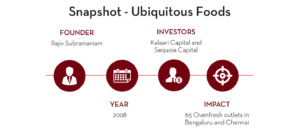While Ubiquitous Foods was founded in 2008 with an initial focus on Ovenfresh, its offline bakery chain, it eventually tapped the online space in 2015, with bulk ordering platform, Eatfresh. Today, the brand follows an omni-channel approach to growth and wants to completely saturate Bengaluru and Chennai market before expanding further.

When Ovenfresh made a foray into the Indian bakery segment, its founder, Rajiv Subramaniam was clear that the brand would focus on two aspects; delivering quality food, customer experience and ambience at affordable prices, and building a national presence for the brand. While the former has and continues to bring in the bucks for the business, the latter took a pivot when Subramaniam learnt some key lessons on choosing profitability and sustainability over rapid expansion. “While our earlier goal was to go pan-India, we realised that there is a great deal more to tap in our existing markets; Bengaluru and Chennai, and taking the slow approach to expansion is a more optimal route, especially with profitability as a key metric,” he opines.
A lot has changed in the Ubiquitous Foods subsidiary brand since it was founded in 2008. Initially, to carve a niche for itself in the unorganised bakery segment, it setup outlets in IT parks and office complexes. Once it reached the 30 mark in Bengaluru and Chennai, it began foraying into the residential retail space, where it setup two outlet formats; a 100 sq.ft to 200 sq.ft kiosk, and a 600 sq.ft to 1,000 sq.ft café format. “Our investors, Kalaari Capital, played a key role in steering our expansion into this space. Having earlier invested in retail businesses like MedPlus, they had a better idea about how we can capitalise on this strategy,” recalls Subramaniam. While the parent brand first raised an undisclosed amount of external capital from Kalaari in 2013, it received a Series B again, to the tune of US $10 million, from its existing investor and Sequoia Capital in 2014.
The second round was channelized towards its Internet-first restaurant brand, EatFresh.
In 2014, while Ubiquitous Foods had plans of setting up 150 Ovenfresh outlets across the metros, it pivoted its strategy to instead set up as many outlets in its existing markets, Bengaluru and Chennai. The belief was; taking the slow approach to expansion is a more optimal route, especially with profitability as a key metric.
Scalability Factor in Foodtech
Eatfresh was initially modelled around offering a daily changing menu to consumers, with chefs making beverages, salads and meals from the brand-owned commercial kitchens, while the entire process from procurement to last mile delivery would also be managed by the team. “However, our learning from this was, while we could achieve fixed scale at its peak, the fundamental economics of this business was not yet robust in the Indian context,” he explains. Meaning, within six months, while the business was delivering up to 3,000 meals a day, the cost of distribution and marketing worked out quite high.
As a result, by end of 2016, the company rejigged its model to focus on its offline brand, Ovenfresh, with the online brand, Eatfresh, catering only to bulk orders such as corporate events and parties. “We realised that there is still a huge opportunity for offline retail businesses to grow. Ovenfresh itself, right from its first outlet to the current, 65th outlet, has been able to maintain the same level of output and profitability,” he states. While currently 95 per cent of its current profits come from the offline business, Subramaniam is pursuing an omni-channel model, with the long term in mind.

Growing In Existing Markets
Even today, the brand spends a meagre portion of its money on marketing. The belief is that; while marketing can generate higher footfalls into the business, recording repeat business and recurring customers is possible only through quality of food and service. “Eventually, the product needs to speak for the brand,” he adds.
Setting aside his earlier plans of seeking rapid growth, Subramaniam now calmly states that the brand will look to further penetrate into Bengaluru and Chennai before exploring other markets. “I’m not saying that we won’t enter into the traditional big cities. But, with the focus now on profitability and a steady growth, we want to completely saturate a market before expanding further. Instead of looking at 100 to 150 outlets pan India, we want to create the same amount of presence in these two cities in the coming years,” he says on a concluding note.
Insights from Ovenfresh
The Market Entry Approach: While the bakery segment was unorganised when we came in, we carved a niche by setting up centres in corporate offices and IT Parks, and later expanded into residential areas, central to both our target customers and corporate offices.
Marketing Approach: The product should speak for the brand. While marketing spends can generate higher footfalls into your outlets, customers come back only for quality of food and service.
Scaling Approach: If profitability and sustainability is your key metric, take a slow approach to growth. Saturate a market before you expand into newer ones.


